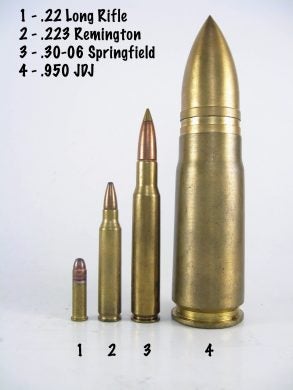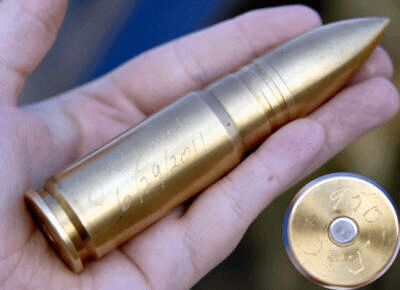Last weekend, a man attending a machine gun shoot was served up more than just a little belt fed action. Positioned 200 – 300 yards from the targets and backstop, the unlucky onlooker “received” a ricochet from what appears to be a .950 JDJ. The round struck the man in the ankle with enough force to break bones and rip through a muck boot. All things being equal, the man and other shoot participants got very lucky – a hit on a more vital part of the body could have easily been fatal.
TFB’s Hrachya H. was able to look at the above image and make the JDJ determination – a round I admittedly never knew existed.
What’s a .950 JDJ?


950 JDJ cases are approximately 70 mm in length, and are based on a 20×110mm case shortened and necked up to accept the .950 in (24.1 mm) bullet. Projectiles are custom-made and most commonly weigh 3,600 grains (230 g) which is 8.2 ounces or over half a pound.
As its name implies, rifles chambered for the cartridge have a groove diameter of 0.950 in (24.1 mm). SSK received a “Sporting Use Exception” to de-regulate the rifles. Thus, in the United States, they can be purchased and owned like any other Title I rifle by an American citizen at age 18. The rifles use McMillan stocks and extraordinarily thick Krieger barrels bearing an 18 lb (8.2 kg) muzzle brake. Overall, depending on options, the rifles weigh from 85 to 120 pounds (39 to 54 kg) and are therefore only useful for shooting from a bench rest or heavy bipod.Despite the weight, recoil is significant and shooters must be sure to choose components (i.e., scopes and bipods) that can handle the abuse. The sheer size, weight, and power of these rifles make them rather impractical for hunting use. SSK only manufactured three of these rifles and as of 2014 no longer produces the ammunition.
Where the ricochet stops…



Here’s a brief excerpt from the original discussion on ar15.com:
A friend attended the machine gun shoot at Southington Offroad Park (SOR) in Garrettsville, Ohio yesterday with some friends of his and ended up taking home an unexpected souvenir. While watching the shoot, he felt a sudden serious pain in his lower leg like someone smashed it with a bat… It left him in a cast with an avulsion fracture and one hell of a bruise, but at least he got a cool story to tell girls at the bar.
What happened to the round?
Apparently one of the staff or volunteers at the event took the round from him, while telling him he wasn’t allowed to have it. He said he was in too much pain to argue and could not walk after them when they started to walk away.
So, how does a projectile this size return in the direction from where it originated with enough force to break a man’s leg? Let’s take a look at the alleged scene:
(I say alleged, not because I don’t believe it didn’t happen, but because I wasn’t there and I have a feeling things are about to get legal.)
To set the scene:



Hmm, a concave rock wall that looks like it will reflect rounds back toward the firing line. After reviewing the NRA’s range building guidelines, I don’t think I remember seeing anything about a curved, hard surface being used as a backstop. A gofundme.com account is being setup to help support the now out of work painter who is the sole provider for his two year old son. Allegedly, the range/event organizer is refusing to pay for medical bills.
Again, I’d say this man was very “lucky” that his injuries were not life threatening, but from the looks of the location pictures, it appears this incident could have been avoided with a professionally built berm.
 Your Privacy Choices
Your Privacy Choices
